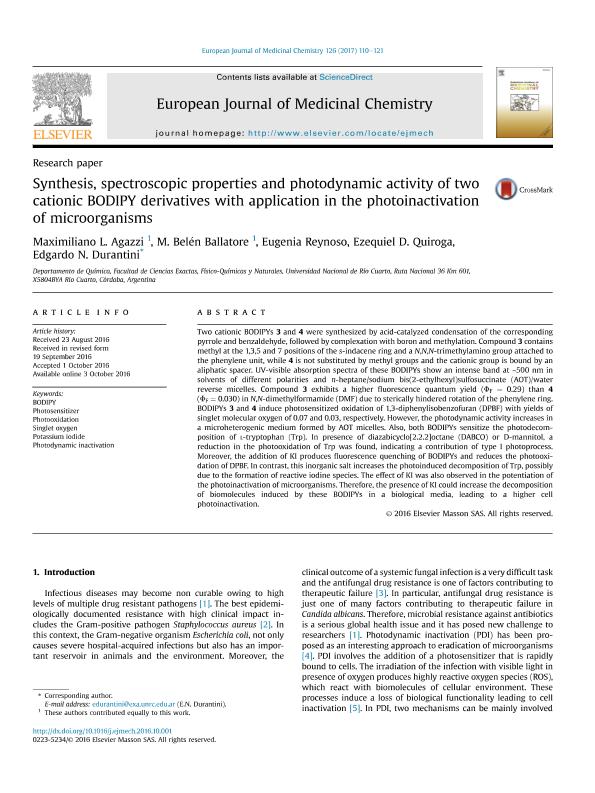Mostrar el registro sencillo del ítem
dc.contributor.author
Agazzi, Maximiliano Luis

dc.contributor.author
Ballatore, María Belén

dc.contributor.author
Reynoso, Eugenia

dc.contributor.author
Quiroga, Ezequiel Dario

dc.contributor.author
Durantini, Edgardo Néstor

dc.date.available
2019-03-29T15:22:58Z
dc.date.issued
2016-10
dc.identifier.citation
Agazzi, Maximiliano Luis; Ballatore, María Belén; Reynoso, Eugenia; Quiroga, Ezequiel Dario; Durantini, Edgardo Néstor; Synthesis, spectroscopic properties and photodynamic activity of two cationic BODIPY derivatives with application in the photoinactivation of microorganisms; Elsevier Masson; European Journal of Medical Chemistry; 126; 10-2016; 110-121
dc.identifier.issn
0223-5234
dc.identifier.uri
http://hdl.handle.net/11336/72820
dc.description.abstract
Two cationic BODIPYs 3 and 4 were synthesized by acid-catalyzed condensation of the corresponding pyrrole and benzaldehyde, followed by complexation with boron and methylation. Compound 3 contains methyl at the 1,3,5 and 7 positions of the s-indacene ring and a N,N,N-trimethylamino group attached to the phenylene unit, while 4 is not substituted by methyl groups and the cationic group is bound by an aliphatic spacer. UV-visible absorption spectra of these BODIPYs show an intense band at ∼500 nm in solvents of different polarities and n-heptane/sodium bis(2-ethylhexyl)sulfosuccinate (AOT)/water reverse micelles. Compound 3 exhibits a higher fluorescence quantum yield (ΦF = 0.29) than 4 (ΦF = 0.030) in N,N-dimethylformamide (DMF) due to sterically hindered rotation of the phenylene ring. BODIPYs 3 and 4 induce photosensitized oxidation of 1,3-diphenylisobenzofuran (DPBF) with yields of singlet molecular oxygen of 0.07 and 0.03, respectively. However, the photodynamic activity increases in a microheterogenic medium formed by AOT micelles. Also, both BODIPYs sensitize the photodecomposition of L-tryptophan (Trp). In presence of diazabicyclo[2.2.2]octane (DABCO) or D-mannitol, a reduction in the photooxidation of Trp was found, indicating a contribution of type I photoprocess. Moreover, the addition of KI produces fluorescence quenching of BODIPYs and reduces the photooxidation of DPBF. In contrast, this inorganic salt increases the photoinduced decomposition of Trp, possibly due to the formation of reactive iodine species. The effect of KI was also observed in the potentiation of the photoinactivation of microorganisms. Therefore, the presence of KI could increase the decomposition of biomolecules induced by these BODIPYs in a biological media, leading to a higher cell photoinactivation.
dc.format
application/pdf
dc.language.iso
eng
dc.publisher
Elsevier Masson

dc.rights
info:eu-repo/semantics/openAccess
dc.rights.uri
https://creativecommons.org/licenses/by-nc-nd/2.5/ar/
dc.subject
Bodipy
dc.subject
Photodynamic Inactivation
dc.subject
Photooxidation
dc.subject
Photosensitizer
dc.subject
Potassium Iodide
dc.subject
Singlet Oxygen
dc.subject.classification
Otras Ciencias Químicas

dc.subject.classification
Ciencias Químicas

dc.subject.classification
CIENCIAS NATURALES Y EXACTAS

dc.title
Synthesis, spectroscopic properties and photodynamic activity of two cationic BODIPY derivatives with application in the photoinactivation of microorganisms
dc.type
info:eu-repo/semantics/article
dc.type
info:ar-repo/semantics/artículo
dc.type
info:eu-repo/semantics/publishedVersion
dc.date.updated
2019-03-21T14:18:44Z
dc.journal.volume
126
dc.journal.pagination
110-121
dc.journal.pais
Francia

dc.journal.ciudad
Paris
dc.description.fil
Fil: Agazzi, Maximiliano Luis. Universidad Nacional de Río Cuarto. Facultad de Ciencias Exactas Fisicoquímicas y Naturales. Departamento de Química; Argentina. Consejo Nacional de Investigaciones Científicas y Técnicas; Argentina
dc.description.fil
Fil: Ballatore, María Belén. Universidad Nacional de Río Cuarto. Facultad de Ciencias Exactas Fisicoquímicas y Naturales. Departamento de Química; Argentina. Consejo Nacional de Investigaciones Científicas y Técnicas; Argentina
dc.description.fil
Fil: Reynoso, Eugenia. Universidad Nacional de Río Cuarto. Facultad de Ciencias Exactas Fisicoquímicas y Naturales. Departamento de Química; Argentina. Consejo Nacional de Investigaciones Científicas y Técnicas; Argentina
dc.description.fil
Fil: Quiroga, Ezequiel Dario. Universidad Nacional de Río Cuarto. Facultad de Ciencias Exactas Fisicoquímicas y Naturales. Departamento de Química; Argentina. Consejo Nacional de Investigaciones Científicas y Técnicas; Argentina
dc.description.fil
Fil: Durantini, Edgardo Néstor. Universidad Nacional de Río Cuarto. Facultad de Ciencias Exactas Fisicoquímicas y Naturales. Departamento de Química; Argentina. Consejo Nacional de Investigaciones Científicas y Técnicas; Argentina
dc.journal.title
European Journal of Medical Chemistry

dc.relation.alternativeid
info:eu-repo/semantics/altIdentifier/doi/http://dx.doi.org/10.1016/j.ejmech.2016.10.001
dc.relation.alternativeid
info:eu-repo/semantics/altIdentifier/url/https://www.sciencedirect.com/science/article/pii/S0223523416308637
Archivos asociados
